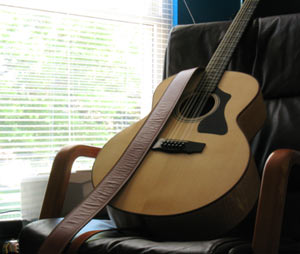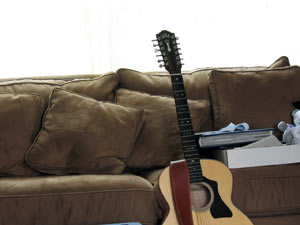Alternate 12 String Guitar Tunings
Many musicians want to enhance their performance abilities. A simple solution is playing on a twelve string in an assortment of tuning opportunities.

"In some circumstances, when playing in alternate tunings, it sounds like two guitars are playing at once," said Jim Winka, a classic rock enthusiast.
After purchasing a twelve string guitar, or pulling it out of the closet after years of not playing, the instrument has either aged, or smells like glue. The strings will be in tune, or not at all. Most songs written are played in standard tuning (E, A, D, G, B, E). Over the vast amount of guitar chords in existence, playing in standard tuning is the route most musicians take.
"If I’m going to play in a different tunings, it’s going to be tuned down a half step. Other times I play in drop D tunings to get a warm, full, D chord sound. When playing with a band, this tuning allows a singer hit the higher registers and ranges. At the same time, it helps me to learn the fret board, and to touch up on my playing," said Shane Biggs, guitarist of Heavy Heart.
Creativity is a key factor in playing in front of audiences. Playing in different tunings allows changed sound patterns, but it also allows playing chords in different positions.
When I play in alternate tunings, from time to time, it's mostly drop D or open E or D tunings, but I am open to different ideas. The most fundamental reason to learn different chord progressions is to have as many "tricks" in your sack as possible. Chord progressions are the framework of many pieces, therefore, when you understand a piece from the inside out, you can embellish upon and adorn the work as you see fit. You are the Architect of the Soundscape.  Your final draft will be a product of the quality and quantity of the different tools and elements your are working with. When you learn and memorize and dissect different chord and interval progressions, new tricks enters that sack, and he or she with the biggest sack wins. I use alternate tunings frequently, but it is relative to style. When playing classical, I use drop D or standard tuning with the G tuned to F# in many pieces. This minor adjustment in standard tuning puts the major 3rd between the 4th and 3rd strings instead of the 3rd and 2nd strings. It makes for some pretty cool chord shapes and sounds. I use alternate tunings to create chord shapes and open string combinations that are difficult or impossible to do in standard tuning, and to just create sounds that are new and unfamiliar. "They offer new ways to do ancient rituals," said Jesse Mazzoccoli, guitarist for Ben Bumbry and the Messengers, and a guitar instructor at Quincy University.
Your final draft will be a product of the quality and quantity of the different tools and elements your are working with. When you learn and memorize and dissect different chord and interval progressions, new tricks enters that sack, and he or she with the biggest sack wins. I use alternate tunings frequently, but it is relative to style. When playing classical, I use drop D or standard tuning with the G tuned to F# in many pieces. This minor adjustment in standard tuning puts the major 3rd between the 4th and 3rd strings instead of the 3rd and 2nd strings. It makes for some pretty cool chord shapes and sounds. I use alternate tunings to create chord shapes and open string combinations that are difficult or impossible to do in standard tuning, and to just create sounds that are new and unfamiliar. "They offer new ways to do ancient rituals," said Jesse Mazzoccoli, guitarist for Ben Bumbry and the Messengers, and a guitar instructor at Quincy University.
Playing in different tunings creates a distinctive sound that only the musician can explore. Following a simple process will prevent having to own two or three guitars for multiple songs. Whenever changing tunings between sets, songs, or even paying a technician to do the work, it’s important to allow the wood to adjust for at least twenty minutes. Another factor to preserving a guitar is using a light string gauge to reduce the amount of stress on the guitar body. Following these simple steps will not only produce the best sound, but at the same time keep the strings in tune and protecting an investment not to be thrown away.
Check out our Online 12-String Guitar Tuner to help you tune your guitar.
Written by Josh Houle












I have played 12 string since age 16-now 64. I have been playing an Adamas 1598 MERB since 2002. I have on order an Emerald X-30-12 with the Hyvibe system and can't wait to see and hear it. I can't explain the love of a 12 string except it's an aquired taste that takes time and patience with a lot of experimentation mixed in but the rewards leave the 6 string behind and you enter a class of it's own. The sound of a 12 in a cathedral is one you won't forget! Remember, the instrument should be an extension of you! It take time and patience to develop that.
It occurred to me that a 12 string guitar might be set up as follows:
a) remove the b and e string pairs.
b) move the other 4 pairs down.
c) replace the two top pairs with strings suitable to be tuned in octaves to G and C
d) tune this to G-C-F-a#-d-g
This would produce a lower toned guitar with octave pairs on all strings and the traditional chord patterns but in a different key.
I am fascinated with this idea but reluctant to try it as it would require nut alteration.
I briefly owned my dream guitar, 1 Ric 360 12-string in Fireglo. Loved the look & feel, except at the nut. The neck is too narrow for a 12-string, and I had to give it up. I've had a Yamaha 12-string acoustic and now have a new Fender 12-string A/E, and both are easier to play (and bar) than the Ric. So, if you're gonna play a 12 and you have average or larger hands/fingers, you may not enjoy that beautiful Ric 12.
I briefly owned my dream guitar, 1 Ric 360 12-string in Fireglo. Loved the look & feel, except at the nut. The neck is too narrow for a 12-string, and I had to give it up. I've had a Yamaha 12-string acoustic and now have a new Fender 12-string A/E, and both are easier to play (and bar) than the Ric. So, if you're gonna play a 12 and you have average or larger hands/fingers, you may not enjoy that beautiful Ric 12.
I've played 12 string guitars for many years and I love 'em. My goal is to own a Rickenbacker 12 in Fireglo.To me, the Ric is the ultimate in electric 12 string guitars. I learned to play and pick on a Hagstrom Electric 12 string. I took a while but I finally learned it. If U wanna play a 12 string, you gotta have patience and a desire to succeed. Have a GREAT DAY.
Thanks for the informative article!